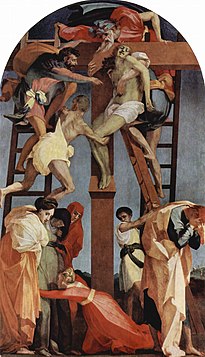
Back النزول من الصليب (لوحة فنية) Arabic Davallament de la creu Catalan Snímání z kříže Czech Kreuzabnahme German Αποκαθήλωση Greek Descendimiento de Jesús Spanish Ristiltvõtmine ET فرود از صلیب FA Descente de croix French Descendemento de Xesús GL

The Descent from the Cross (Greek: Ἀποκαθήλωσις, Apokathelosis), or Deposition of Christ, is the scene, as depicted in art, from the Gospels' accounts of Joseph of Arimathea and Nicodemus taking Christ down from the cross after his crucifixion (John 19, John 19:38–42). In Byzantine art the topic became popular in the 9th century, and in the West from the 10th century. The Descent from the Cross is the 13th Station of the Cross, and is also the sixth of the Seven Sorrows of the Blessed Virgin Mary.
Other figures not mentioned in the Gospels who are often included in depictions of this subject include John the Evangelist, who is sometimes depicted supporting a fainting Mary (as in the work below by Rogier van der Weyden), and Mary Magdalene. The Gospels mention an undefined number of women as watching the crucifixion, including The Three Marys, (Mary Salome being mentioned in Mark 15 (Mark 15:40)), and also that the Virgin Mary and Mary Magdalene saw the burial (Mark 15:47). These and further women and unnamed male helpers are often shown.[1]
- ^ G. Schiller, Iconography of Christian Art, Vol. II, 1972 (English trans from German), Lund Humphries, London, p.164, ISBN 0-85331-324-5